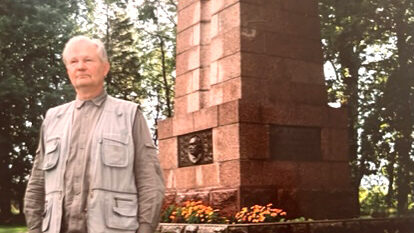In fact he was scheduled for a meeting with the MVD where he informed a polkovnik Beljajev of all the possible resistance members whom he had befriended. From there he continued to the Kirov oblast to continue his studies. In the meanwhile in Estonia thousands of suspects were arrested by the MVD, some of whom were individuals betrayed by Tuldava-Haman.
In 1947 Tuldava-Haman married Ruth Kerem in the Kirov oblast, the daughter of a pre-war cabinet minister who had also been deported to a labour camp. They had a son. But Tuldava-Haman denied having a family when he appeared in the West as an escaped defector. Otherwise it would have been impossible to convince Western intelligence agencies that he had not been sent by the Soviet services. It was known that close family members, remaining behind, could be “held hostage” as a guarantee that he fulfill his assignment and not genuinely defect or become a double agent for the West.
When Tuldava-Haman graduated from the pedagogical institute in 1948 he was not placed into a government-chosen job like all his-fellow graduates were. Such was the practice through the USSR. The graduate does not get to choose his first place of work. The choice is made by others. In fact Tuldava-Haman could not explain where he spent that year after graduating. In fact he was in Leningrad with the MVD.
Upon arrival in Tallinn in 1949 he was quickly granted legal residency status in the city, again unusual for someone who had been exiled for political reasons, and given part of a large apartment during a period of severe housing shortage. He was offered a part-time teacher's position so he would have plenty of time to organize an anti-Soviet resistance group. He was able to recruit the son of a former minister, an agronomist and many other patriotic Estonians. Men named Silber and Ruubel held second-in-command positions under his leadership. The group was to be prepared to provide armed assistance to Western forces when they attacked the Soviet Union. This attracted many to the cause. From 1949 to 1952 this was Tuldava-Haman's main activity.
He made regular trips to Leningrad with the explanation that his part-time job didn't provide sufficient income. This had to be augmented by working the black market.
During this period security authorities under Ivan Karpov arrested two or three members of the group confirming to the others that they were part of an authentic resistance movement. In 1952 all members of the group were arrested, except for Tuldava-Haman. He “was not found”. The MVD spread rumors around Tallinn that he was wanted and being actively sought. Haman later explained that he fled to Riga where he lived under the name of Jugans from 1952 to 1955. In fact he was being trained for service abroad.
During his time he also regularly visited the port city of Ventspils. He contacted sailors from Western ships to whom he gave letters to be posted to US, British and Swedish counter-intelligence services. All letters contained his photo and an offer to assist the West in infiltrating Latvian and Estonian resistance groups. They were to send a person with a similar appearance to himself with whom he would exchange clothes and identities, and Tuldava-Haman would take the individual's place on board ship. In all, 12 letters thus posted reached the respective destinations. He received no replies.
His MVD handlers were getting restless. When a musician from Sweden visited Riga as a tourist, Tuldava-Haman made contact with him and persuaded him to post a letter addressed to his relatives asking them to inform Swedish intelligence services of Tuldava-Haman's proposal. Again no answer.
The MVD in Leningrad realized the operation wasn't producing results. One last letter was handed over to a Western sailor in Leningrad on his way to Hamburg. The Germans also failed to answer. Western intelligence services had become wary of Tuldava-Haman's insistent approach and these establishments in general have a policy of rejecting “walk ins” – unknown individuals who offer their services. In addition Tuldava-Haman's knowledge of the whereabouts of various Western intelligence services increased their suspicions.
It was obvious to the Soviets that getting Tuldava-Haman to the West needed another plan. This time the route was to be through Finland. An Estonian MVD operative, Oskar S., who worked in Viiburi, was brought to Riga to meet with Tuldava-Haman. This was meant to have the two men get acquainted, to help the operation proceed smoothely later on. (To be cont'd.)
Laas Leivat




